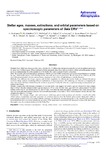Stellar ages, masses, extinctions, and orbital parameters based on spectroscopic parameters of Gaia DR3

Use este enlace para citar
http://hdl.handle.net/2183/32817
Excepto si se señala otra cosa, la licencia del ítem se describe como Atribución 4.0 International (CC BY 4.0)
Colecciones
- Investigación (FIC) [1685]
Metadatos
Mostrar el registro completo del ítemTítulo
Stellar ages, masses, extinctions, and orbital parameters based on spectroscopic parameters of Gaia DR3Autor(es)
Fecha
2023Cita bibliográfica
G. Kordopatis, M. A. Álvarez, et al., "Stellar ages, masses, extinctions, and orbital parameters based on spectroscopic parameters of gaia DR3", Astronomy and Astrophysics, 669, 2023 [Online]. doi:10.1051/0004-6361/202244283
Resumen
[Abstract]: Gaia's third data release provides radial velocities for 33 million stars and spectroscopically derived atmospheric parameters for more than 5 million targets. When combined with the astrometric data, these allow us to derive orbital and stellar parameters that are key to understanding the stellar populations of the Milky Way and to perform Galactic archaeology. Aims. We used the calibrated atmospheric parameters, 2MASS and Gaia-EDR3 photometry, and parallax-based distances to compute the ages, initial stellar masses, and reddenings for the stars with spectroscopic parameters. We also derived the orbits for all of the stars with measured radial velocities and astrometry, adopting two sets of line-of-sight distances from the literature. Methods. Four different sets of ages, masses, and absolute magnitudes in different photometric bands are obtained through an isochrone fitting method, considering different combinations of input parameters. The reddenings are obtained by comparing the observed colours with those obtained from the isochrone projection. Finally, the orbits are computed adopting an axisymmetric potential of the Galaxy. Results. Comparisons with reference catalogues of field and cluster stars suggest that reliable ages are obtained for stars younger than 9-10 Gyr when the estimated relative age uncertainty is < 50 per cent. For older stars, ages tend to be underestimated. The most reliable stellar type for age determination are turn-off stars, even when the input atmospheric parameters have large uncertainties. Ages for giants and main-sequence stars are retrieved with uncertainties of the order of 2Gyr when extinction towards the star's line of sight is less than AV ≤ 2.5 mag. Conclusions. The catalogue of ages, initial stellar masses, reddenings, galactocentric positions and velocities, as well as the stellar orbital actions, eccentricities, apocentre, pericentre and maximum distance from the Galactic plane reached during their orbits, is made publicly available to be downloaded. With this catalogue, the full chemo-dynamical properties of the extended solar neighbourhood unfold and allow us to better identify the properties of the spiral arms, to parametrise the dynamical heating of the disc, and to thoroughly study the chemical enrichment of the Milky Way.
Palabras clave
Galaxy: kinematics and dynamics
Galaxy: stellar content
Stars: fundamental parameters
Galaxy: stellar content
Stars: fundamental parameters
Versión del editor
Derechos
Atribución 4.0 International (CC BY 4.0)






